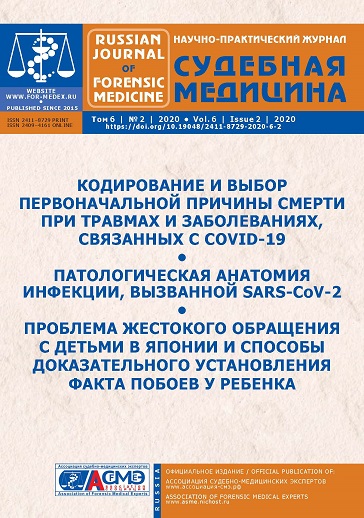ВИРТОПСИЯ В ЧЕШСКОЙ РЕСПУБЛИКЕ
- Авторы: Фришонс Я.1, Навотны В.2, Рейтар П.2, Хейна П.3, Кислов М.А.4,5, Чумакова Ю.В.4,5
-
Учреждения:
- Университет им. Масарика и Университетская больница Святой Анны, Брно Карлов университет и Университетская больница Градец-Кралове
- Карлов университет и Университетская больница Градец-Кралове
- Медицинский факультет Карлова университета и Университетская больница Градец-Кралове
- ГБУЗ МО «Бюро судебно-медицинской экспертизы»
- ГБУЗ МО «Московский областной научно-исследовательский клинический институт им. М. Ф. Владимирского»
- Выпуск: Том 6, № 2 (2020)
- Страницы: 44-48
- Раздел: Виртопсия
- Дата подачи: 02.07.2020
- Дата принятия к публикации: 02.07.2020
- Дата публикации: 02.07.2020
- URL: https://for-medex.ru/jour/article/view/312
- DOI: https://doi.org/10.19048/2411-8729-2020-6-2-44-48
- ID: 312
Цитировать
Полный текст
Аннотация
Посмертная компьютерная томография используется в судебно-медицинской практике с 1990-х годов, после чего стала проводиться посмертная магнитно-резонансная томография. Одно из первых исследований было проведено в Германии в 1983 году. Первое же обследование трупа с помощью КТ в Чешской Республике было проведено в 1993 году.
Проведение исследования занимает около 30 минут, при этом самым сложным является реконструкция данных изображения. Выявлено, что КТ больше подходит для обследования скелета, а МРТ-контрастирование превосходит КТ в визуализации мягких тканей. В Чешской Республике КТ-исследование обязательно в следующих случаях смерти: при огнестрельных, дорожно-транспортных и авиационных происшествиях, падениях с большой высоты, в случаях производственных и взрывных травм, тел с термическими или механическими разрушениями, неизвестных лиц, в случаях удушения, тел, извлеченных из воды, гибель детей и подростков в возрасте до 18 лет и тела с гнилостными явлениями.
КТ до вскрытия — это, по сути, ориентационный GPS медицинского эксперта. Таким образом можно выявить патологические изменения еще до инвазивного рассечения отдельных структур, которые при традиционном исследовании труднодоступны или недоступны. Преимущество КТ-обследования заключается в получении объективных данных, которые можно повторно обработать и интерпретировать или сопоставить с результатами вскрытия, а также упростить процедуру восстановления данных в случаях назначения повторных экспертиз.
Ключевые слова
Об авторах
Я. Фришонс
Университет им. Масарика и Университетская больница Святой Анны, БрноКарлов университет и Университетская больница Градец-Кралове
Автор, ответственный за переписку.
Email: jan.frishons@fnusa.cz
препаратор, лаборант, кафедра судебной медицины медицинского факультета;
кафедра радиологии медицинского факультета,
Градец-Кралове
ЧехияВ. Навотны
Карлов университет и Университетская больница Градец-Кралове
Email: novotvac1@seznam.cz
pентгеновский лаборант, кафедра радиологии медицинского факультета,
Градец-Кралове
ЧехияП. Рейтар
Карлов университет и Университетская больница Градец-Кралове
Email: pavel.rejtar@fnhk.cz
главный врач, кафедра радиологии медицинского факультета,
Градец-Кралове
ЧехияП. Хейна
Медицинский факультет Карлова университета и Университетская больница Градец-Кралове
Email: dr.petrhejna@gmail.com
ORCID iD: 0000-0002-9308-624X
д-р наук, доц., директор Института судебной медицины Карлова университета и Университетской больницы Градец-Кралове,
Градец-Кралове
ЧехияМ. А. Кислов
ГБУЗ МО «Бюро судебно-медицинской экспертизы»;ГБУЗ МО «Московский областной научно-исследовательский клинический институт им. М. Ф. Владимирского»
Email: kislov@sudmedmo.ru
ORCID iD: 0000-0002-9303-7640
д.м.н., доц., зав. Пушкинским судебно-медицинским отделением;
проф. кафедры судебной медицины,
Москва
РоссияЮ. В. Чумакова
ГБУЗ МО «Бюро судебно-медицинской экспертизы»;ГБУЗ МО «Московский областной научно-исследовательский клинический институт им. М. Ф. Владимирского»
Email: chumakova@sudmedmo.ru
ORCID iD: 0000-0002-9738-8288
зав. Лобненским судебно-медицинским отделением;
аспирант кафедры судебной медицины,
Москва
РоссияСписок литературы
- Кильдюшов Е. М., Егорова Е. В., Буренчев Д. В. Современные возможности лучевой диагностики в судебной медицине. Судебная медицина. 2019;5(4):4–8. https://doi.org/10.19048/2411-8729-2019-5-4-4-8
- Клевно В. А., Чумакова Ю. В. Виртопсия — новый метод исследования в практике отечественной судебной медицины. Судебная медицина. 2019;5(2):27–31.
- Клевно В. А., Чумакова Ю. В., Павлик Д. П., Дуброва С. Э. Возможности виртуальной аутопсии при огнестрельной травме. Russian Journal of Forensiс Medicine. 2019;5(3):33–38.
- Schumacher M., Oehmichen M., König H. G., Einighammer H., Bien S. Computer tomographic studies on wound ballistics of cranial gunshot injuries. Beitr Gerichtl Med. 1985(43):95–101.
- Thali M., Dirnhofer R., Vock P. The virtopsy approach: 3D optical and radiological scanning and reconstruction in forensic medicine. 2010.
- Ebert L. C., Ptacek W., Naether S., Fürst M., Ross S., Buck U., et al. Virtobot-a multi-functional robotic system for 3D surface scanning and automatic post mortem biopsy. Int J Med Robot. 2010;6(1):18–27.
- Grabherr S., Grimm J., Dominguez A., Vanhaebost J., Mangin P. Advances in post-mortem CT-angiography. Br J Radiol. 2014;87(1036):20130488.
- Hejna P., Šafr M., Ublová M. a kol. První virtuální pitva v České republice usvědčila vraha ze lži. Fol Soc Med Leg Slov. 2015;(5):11–16. (In Czech).
- Vaněčková M., Seidl Z., Goldová B., et al. Post-mortem fetal magnetic resonance — examination technique. Česká Radiologie. 2008;62(4):384–387.
- Urbanová P., Jurda M., Čuta M. Recording and analysis of digital data in anthropology. 1st ed. Brno: Masaryk University, 2015. 120 p.
- Hejna P., Sokol M., Rejtar P., Horák V. Methods of visualization in forensic medicine. In: Hirt M., Vorel F., et al. Forensic Medicine. Part II. Prague, 2016. P. 204–208.
Дополнительные файлы










